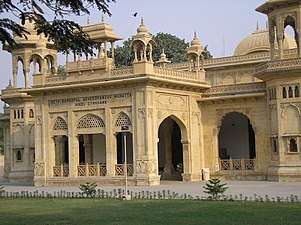Hindu Gymkhana, Karachi
| Hindu Gymkhana | |
|---|---|
| ہندو جِمخانہ | |
 The Hindu Gymkhana Building now houses the National Academy of Performing Arts. | |
| General information | |
| Type | Headquarters for the National Academy of Performing Arts |
| Location |
Saddar Karachi Pakistan |
| Completed | 1925 |
| Design and construction | |
| Architect | Agha Ahmed Hussain |
The Hindu Gymkhana (Sindhi:هندو جمخانه; Urdu: ہندو جِمخانہ) is a colonial-era building located on Sarwar Shaheed Road in Karachi, Pakistan. Established in 1925 a club for the Hindu upper classes who formed colonial-era Karachi's commercial elite, the Hindu Gymkhana was the first public building in Karachi to adopt the Mughal-Revival architectural style. It currently houses the National Academy of Performing Arts.
History
The Hindu community and Seth Ramgopal Gourdhanandh Mohatta contributed money for construction of the building, which was completed in 1925.
The building's condition deteriorated over the years, and it was almost demolished in 1984. It was protected by the intervention of the Heritage Foundation of Pakistan. The Hindu Gymkhana now houses Pakistan's National Academy of Performing Arts.
Architecture
The building was designed by architect Agha Ahmed Hussain, with a design based on the tomb of Itamad-ud-Daulah (1628) in Agra.
The building is small in size and consists primarily of a hall and some smaller rooms used for administrative purposes. Stone for the 2-foot-thick (0.61 m) walls was acquired in Bijapur. The roof line is defined by delicate massing of cupolas and balustrades directly influenced by Akbar's Fatehpur Sikri. The octagonal corner towers framing the projecting central jharoka are capped with chattris, highlighting the influence of Rajasthani Style of Palaces. Smaller chattris highlight the corners of the projecting porch that carry the drooping bangladar roof used in Emperor Akbar's period.
The projecting chajjas are supported by ornamental brackets. The cupolas of the chattris are reinforced concrete and the walls are dressed in Gizri stone. Some of the carved elements are of Jodhpur stone.
See also
References
- Nuha Ansari. 1997. Karachi: Edge of Empire. Karachi: Ferozsons (Pvt) Ltd.,71.
- Yasmeen Lari and Mihail S. Lari. 1996. The Dual City: Karachi During the Raj. Karachi: Oxford University Press, 328-9.
External links
| Wikimedia Commons has media related to Hindu Gymkhana, Karachi. |